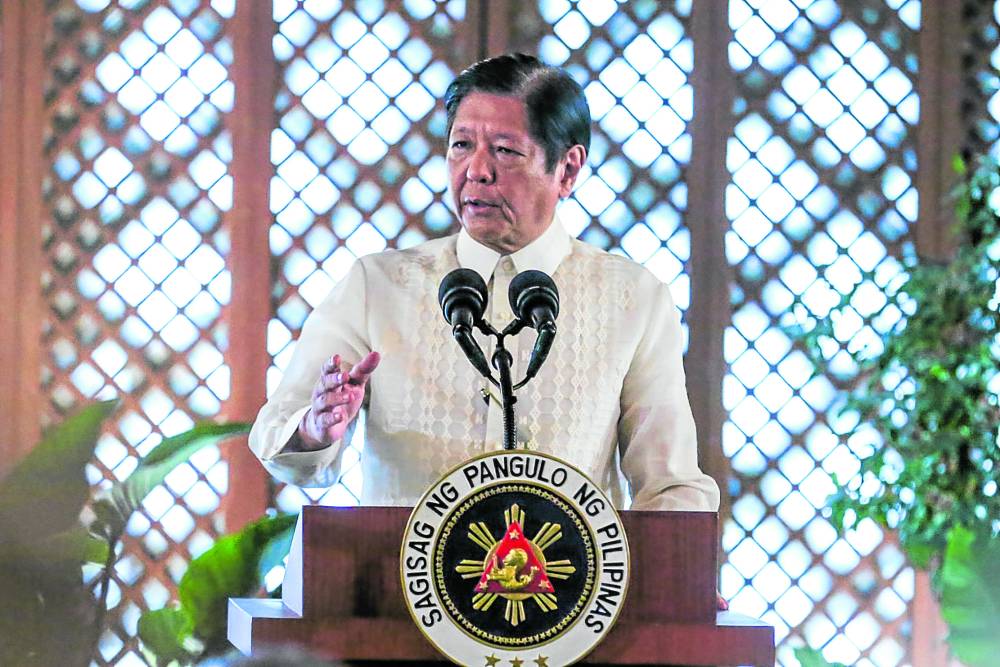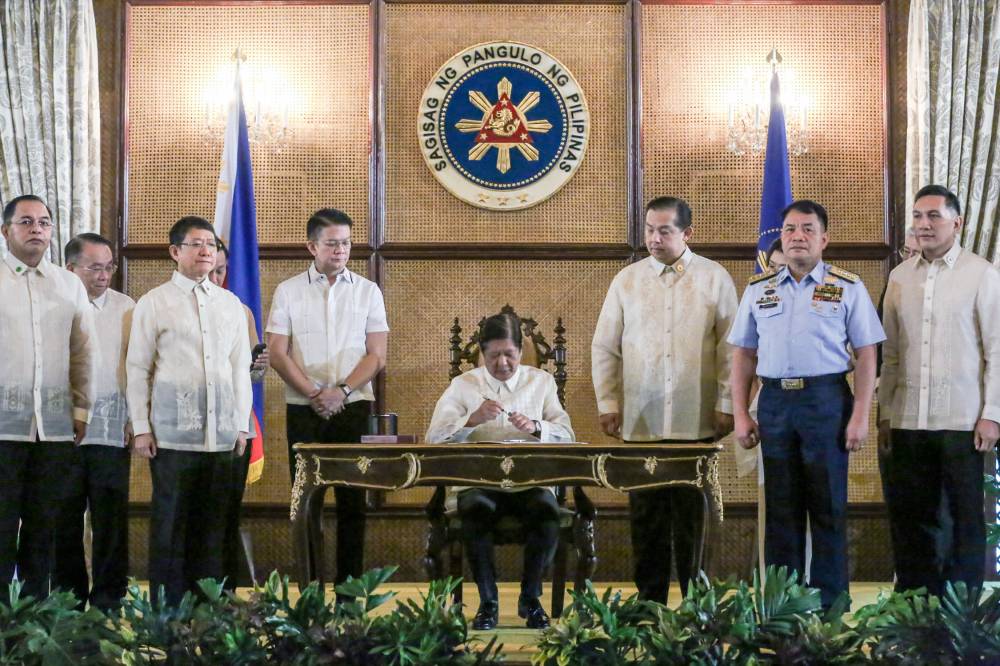PH affirms maritime zones, angering China

President Marcos on Friday enacted two laws that defined the country’s maritime zones and its archipelagic sea-lanes and air routes to assert the Philippines’ rights over its waters, especially the West Philippine Sea.
Republic Act No. 12064, or the Philippine Maritime Zones Act, and Republic Act No. 12065, or the Philippine Archipelagic Sea Lanes Act, emphasize the importance of the country’s maritime and archipelagic identity, he said after signing the measures in Malacañang.
“With these pieces of legislation, we align our domestic laws with international law, specifically the United Nations Convention on the Law of the Sea (Unclos), improve our capacity for governance, and reinforce our maritime policies for economic development and for national security,” he said.
Message to the world
RA 12064 identified the country’s maritime zones, such as its internal waters, archipelagic waters, a 22.22-kilometer (12-nautical-mile) territorial sea, a 44.45-km (24-nautical-mile) contiguous zone from the baseline, a 370-km (200-nautical-mile) exclusive economic zone (EEZ), and continental shelf in compliance with the Unclos, existing laws and treaties.
The President said that “by defining and asserting our maritime zones, we project to the international community that we are staunchly committed to nurturing, cultivating and protecting our maritime domain.”
Beijing summons PH envoy
“Maintaining the primacy of the Unclos and the 2016 Arbitral Award as our beacons in the maritime domain, the Philippines reaffirms its sovereignty, sovereign rights and jurisdiction in our waters,” he said.
After Mr. Marcos enacted the two congressional bills, China summoned the Philippines’ Ambassador to Beijing, Jaime FlorCruz, on Friday to make “solemn representation,” lodging “stern protest.”

Beijing’s foreign ministry condemned the move as an attempt to “solidify the illegal ruling of the South China Sea arbitration case through domestic legislation.”
The maritime zones law “illegally includes most of China’s Huangyan Island and Nansha Islands and related maritime areas in the Philippines’ maritime zones,” Beijing’s foreign ministry spokesperson Mao Ning said, using the Chinese names for Panatag (Scarborough) Shoal and the Spratly Islands, respectively.
The move “seriously infringes on China’s territorial sovereignty and maritime rights and interests in the South China Sea,” Mao said. “China strongly condemns and firmly opposes it,” she said.
Tool for enforcement
Mr. Marcos said that in clearly defining its maritime zones, the law will help the country enforce its domestic laws and related international laws to protect and conserve its marine environment and resources and enhance maritime safety and security.
He said RA 12064 was “essential in establishing the extent of our maritime jurisdiction and to ensure that our rights and duties as an archipelagic state are well-defined in order that all Filipinos can rightfully enjoy the riches of our seas.”
“Our people, especially our fisherfolk, should be able to pursue their livelihood free from uncertainty and harassment. We must be able to harness mineral and energy resources in our seabed,” he said.
Beijing warned Manila that its actions could escalate their maritime dispute.
“China urges the Philippine side to effectively respect China’s territorial sovereignty and maritime rights and interests, to immediately stop taking any unilateral actions that may lead to the widening of the dispute and complicate the situation,” Mao said.
Designated sea-lanes
RA 12065 designates the country’s archipelagic sea-lanes and air routes that foreign military and foreign registered vessels and aircraft can use under the Unclos and the Convention on International Civil Aviation, the “Chicago Convention,” for their “continuous and expeditious passage” across the Philippine archipelago.
Archipelagic sea-lanes are a series of continuous axis lines that are not more than 46 km (25 nautical miles) on either side, from the entry points of passage routes to the exit points.
The law establishes two east-west routes and one north-south route.
• Sea-Lane I is the Philippine Sea – Balintang Channel – West Philippine Sea.
• Sea-Lane II is the Celebes Sea – Sibutu Passage – Sulu Sea – Cuyo East Pass – Mindoro Strait – West Philippine Sea.
• Sea-Lane III is the Celebes Sea – Basilan Strait – Sulu Sea – Nasubata Channel – Balabac Strait – West Philippine Sea.
Innocent passage
Beyond the archipelagic sea-lanes, foreign ships have the right of innocent passage, but this can be suspended. A state may not impede or suspend the archipelagic sea-lanes passage unless it is essential for the country’s security.
In archipelagic sea-lanes passage, submarines can operate submerged. In innocent passage, submarines must operate on the water’s surface and show their flags.
The President said that the government will implement these routes in “faithful accordance” with Unclos processes while upholding “reciprocity and mutual respect amongst states.”
He said the two laws are close to his heart as he was part of the 14th Congress that passed the 2009 Philippine Archipelagic Baselines Act.
“These measures prove not only our commitment to ensuring the safety and prosperity of our maritime domain, but also our firm faith in our identity as a maritime nation. It is a spirit that transcends administrations. It is an intrinsic and undeniable part of the national—the Filipino—character,” Mr. Marcos said.
Against China’s claims
Senate Majority Leader Francis Tolentino, the principal author of the twin laws, said both would enshrine and implement the 2016 arbitral award that nullified China’s sweeping claims to the South China Sea, including the West Philippine Sea, waters within the country’s EEZ.
“By passing these laws, we seek to bolster international recognition for the Philippines’ assertion of its territorial and maritime rights, as well as the practice of making official references to the ‘West Philippine Sea’ in global maritime and aviation systems,” Tolentino said in a statement.
“The ‘West Philippine Sea’ will be more than just a term, but will be formally defined and enshrined for the first time in national legislation. Consider this as the ‘birth certificate’ of the (West Philippine Sea),” he added.
The law mandates the National Mapping and Resource Information Authority (Namria) to determine the exact metes and bounds of the country’s maritime zones and archipelagic sea-lanes according to the two laws.

Int’l ‘imprimatur’
Namria Administrator Peter Tiangco said the delineation of the maritime zones and archipelagic sea-lanes were ready and that they were just waiting for the two laws’ implementing rules and regulations before publishing the official map.
“This is our title to our territorial sea, our contiguous zone. So instantly, the tensions in the exclusive economic zone will be diluted. Although China is not recognizing this, the imprimatur that we will be getting from the international community will strengthen our position,” Tolentino said during a press briefing.
He said the archipelagic sea-lanes will be submitted to the International Maritime Organization for approval prior to enforcement after proper notice to all vessels and aircraft around the world. The air routes would be above the sea-lanes, according to the law.
‘Defense of maritime domain’
Speaker Martin Romualdez said the enactment of the two measures “mark a historic moment in our efforts to secure and defend our maritime domain.”
The two laws send “signals to our neighbors, our allies, and to the whole world our steadfast commitment to protect what is rightfully and legally ours,” Romualdez said.
Senate President Pro Tempore Jinggoy Estrada, chair of the national defense committee, said the enactment of the measures would help fortify the Philippines’ “governance capabilities, reinforce maritime policies for economic development and ensure national security.”
Sen. Risa Hontiveros, a coauthor of the maritime zones act, said “these new laws help secure what is ours—our waters, our rich marine life—today and for future generations.”
The measures would give the Philippines a legal framework in enforcing domestic laws on maritime matters, said Sen. Sherwin Gatchalian, coauthor of both laws.
Boundaries just clarified
Maritime expert Jay Batongbacal, said the laws merely clarified the boundaries of the Philippine claims in the South China Sea. “We did not expand our claims,” he told reporters.
Batongbacal, who heads the Institute for Maritime Affairs and Law of the Sea of the University of the Philippines College of Law, said the new laws were “foundational pieces of legislations” that were aligned with the Unclos.
“It’s not only the Filipino people who are bound to comply with it but the international community as long as we implement our rules and regulations in accordance with Unclos,” he said.
The new Philippine map, which would be released soon, would be “the final step that would clarify how far is ours” in the South China Sea, Batongbacal added. —WITH REPORTS FROM MARLON RAMOS, NESTOR CORRALES, AP AND REUTERS





















